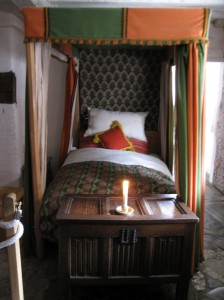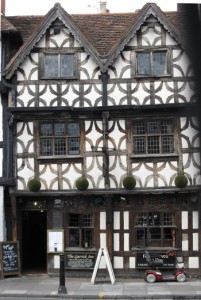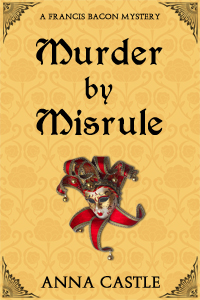 Relevant History welcomes Anna Castle, who lives in Austin, Texas and writes the Francis Bacon Mysteries. The first book in the series, Murder by Misrule, has been chosen as a Kirkus Indie Book of the Month for July. The book will be released everywhere June 8, 2014. For more information, check her web site, and look for her on Facebook.
Relevant History welcomes Anna Castle, who lives in Austin, Texas and writes the Francis Bacon Mysteries. The first book in the series, Murder by Misrule, has been chosen as a Kirkus Indie Book of the Month for July. The book will be released everywhere June 8, 2014. For more information, check her web site, and look for her on Facebook.
*****
The monarchs and courtiers of the Tudor period are so well-known and so colorful, we tend to see the whole sixteenth century in terms of their tumultuous lives. But the nobility and gentry were only 2% of the population. There were three other classes: the citizens (merchants and professionals, like lawyers), yeomen (farmers with 100 acres or more), and the common folk. The middling sort—merchants and yeomen—interest me the most, perhaps because that’s where I imagine I would have been in those days.
We also tend to imagine that everyone except the ruling class was oppressed. Maybe that was true in some places, but it was most emphatically not the case in England. Women ran businesses, trained apprentices, and waged lawsuits on their own recognizance throughout the period. The laws concerning married women were very restrictive, but as with so many Tudor laws, there were ways around them (and ways to exploit them). Short life expectancies meant that many women became widows who could own, sell, sue, hire, and fire almost as freely as men. Then they could marry again and climb another rung up the social ladder.
One woman leaps into history
One woman who stepped in to manage a prosperous business between husbands was Elizabeth Pickering Redman. In 1540, she published the first book known to have been printed by a woman in England from her shop on Fleet Street. She took over the press after her husband, Robert Redman, died. We don’t know when she was born or married; she leaps into history at Robert’s death, when she is named as the executrix of his will. She inherited the customary widow’s third of his estate. The first portion went to bequests and funeral expenses, the second to the children, two daughters. Redman was worth about £300, so Elizabeth would have gotten something less than £100, after expenses and debts were deducted, and the contents of the “widow’s chamber”: clothing, jewelry, and furniture.
 [Photo by author: A bed in Shakespeare’s Birthplace, Stratford-upon-Avon.] Translating sums is always ticklish. All I know is that a gentleman could live decently at the fashionable Inns of Court on £60 later in the century, so that hundred pounds was a goodly sum. And beds were important status symbols as well as places to lay one’s head at night.
[Photo by author: A bed in Shakespeare’s Birthplace, Stratford-upon-Avon.] Translating sums is always ticklish. All I know is that a gentleman could live decently at the fashionable Inns of Court on £60 later in the century, so that hundred pounds was a goodly sum. And beds were important status symbols as well as places to lay one’s head at night.
Redman left no specific instructions for his press. Elizabeth seems to have taken charge of the business on her own initiative. He had built a successful specialty in law books, his shop not far from the Inns of Court where dwelled his principal customers. She married a lawyer of Lincoln’s Inn, William Chomeley, sometime in 1541. Did she meet him over the counter in her shop?
 [Photo by author: an Elizabethan town house. Stratford-upon-Avon.] Chomeley owned property on both sides of Fleet Street, including the house he and Elizabeth lived in. Chomeley became a member of the Stationers’ Guild in 1541, perhaps in anticipation of marrying a woman with a printers’ shop.
[Photo by author: an Elizabethan town house. Stratford-upon-Avon.] Chomeley owned property on both sides of Fleet Street, including the house he and Elizabeth lived in. Chomeley became a member of the Stationers’ Guild in 1541, perhaps in anticipation of marrying a woman with a printers’ shop.
Elizabeth published at least ten books as mistress of her press. Printers usually identified themselves in the colophon at the bottom of the title page. Elizabeth identified herself variously as “Elisabeth late wyfe to Robert Redman”, “Elysabeth wydow of Robert Redman, or sometimes “Elisabethe Pykerynge, viduam R. Redmani.” She wasn’t the only woman publishing books at that time or using her maiden name to do so: three French women, also widows, used their maiden names to identify their printed works. (Apparently, the “better sort” of women in France and the Netherlands used their maiden names. I’m astonished to learn this curious fact and wondering how I can use it as a confounder in a future plot.) Elizabeth printed law books, an Herbal—and a book called Seynge of Urynes, about analyzing the colors of urine to diagnose disease, a centerpiece of medical practice at that time.
She can’t have just walked home from the funeral and started ordering the journeymen about. She must have been involved in the business for some time, long enough to know how to choose a marketable project, oversee the design of both interior pages and the all-important title page, arrange to have the pages assembled and bound, and then sell the finished product at a profit. Redman’s apprentices most likely lived with the family, under Elizabeth’s daily supervision. I think we can safely assume that she was involved in every aspect of the family business on a daily basis. We can also assume without risk of anachronism that she was a self-motivating woman of strong mind and character who wasn’t afraid to tell men what to do.
Elizabeth’s descendants
Robert Redman was her second husband. They had two daughters, Mildred and Alice. She and her first husband, a man named Jackson, also had two daughters, Lucy and Elizabeth. She and Chomeley had no children; he left his wealth to her daughters. Elizabeth died in 1562.
It’s a narrow glimpse into life for women in Tudor times, but I hope a revealing one. Elizabeth Pickering Jackson Redman Chomeley had charge of her own life in important ways. When her husband died, instead of flinging herself on the metaphorical funeral pyre, she stepped into his shoes and thus walked into the history books.
(Source: Kreps, Barbara. 2003. “Elizabeth Pickering: The first woman to print law-books in England and the community of Tudor London’s printers and lawyers,” Renaissance Quarterly, Vol. 56, No. 4 (Winter, 2003), pp. 1053-1088.)
*****
 A big thanks to Anna Castle. She’ll give away an electronic copy, any format, of Murder by Misrule to someone who contributes a comment on my blog this week. I’ll choose the winner from among those who comment by Friday at 6 p.m. ET.
A big thanks to Anna Castle. She’ll give away an electronic copy, any format, of Murder by Misrule to someone who contributes a comment on my blog this week. I’ll choose the winner from among those who comment by Friday at 6 p.m. ET.
**********
Did you like what you read? Learn about downloads, discounts, and special offers from Relevant History authors and Suzanne Adair. Subscribe to Suzanne’s free newsletter.

I’m always fascinated by what research can discover about people’s lives. This was an interesting post.
Thanks, Jody! It isn’t easy to uncover information about women in those days, so we tend to assume they didn’t do much. But I want active female characters, so it’s worth digging.
In such a short article, you cover so much: women’s lives of the period, publishing, inheritance, printing and commerce. Fascinating.
Thanks, Lida! I barely scratched the surface of that article. These historians really amaze me: how deeply they dig into the dry public records to put together a narrative. All there for me to work my wicked way with!
I gotta admit that this essay struck a nerve with me. Some readers panned the protagonist of my award-winning first book, PAPER WOMAN, because she ran her father’s printing press in Georgia during the American Revolution. The protagonist was labeled “disreputable” because she worked, and her occupation was deemed “unsuitable for a woman.”
It’s a common misperception that women have been delicate, domestic damsels throughout history. The truth is that women have done what they’ve needed to do to make sure that they and their families survive. They’ve been lighthouse keepers, blacksmiths, gunsmiths, coach makers, soldiers — just about every profession out there.
Suzanne, I am right there with you. That’s one of the biggest myths of history: that women were incapable and uninvolved in adult trade and commerce. Women not only work for family survival, they work because they want to. They have just as much pride and pleasure in achievement as men; always have, always will. Women work side by side with their husbands in the family business and if the husband dies, they keep right on going. As often as not, they marry their journeyman or a competitor or an investor, like Elizabeth Pickering did.
People look at the legal code and think it’s a description of social reality. It’s wishful thinking! Laws are one thing; reality is something else entirely.
[OK, off the soap box.]
Loved the post – I always enjoy reading about history and in particular women.
Thanks, Carolyn! Y’all are inspiring me to get more glimpses into working women’s lives into my own blog.
Anna, that sounds like a great idea for a blog feature. You could grab people with the title “Working Girls.”
An excellent resource on the professions of women throughout history is Leslie Sackrison’s book AWESOME WOMEN. The book is out of print now, but there are copies floating around.
Thanks for the ref, I’ll look for it. I have a great library. In my TBR pile right now is Working Women in English Society, 1300-1620, by Marjorie Keniston McIntosh. Maybe I’ll just blog each chapter as I go!